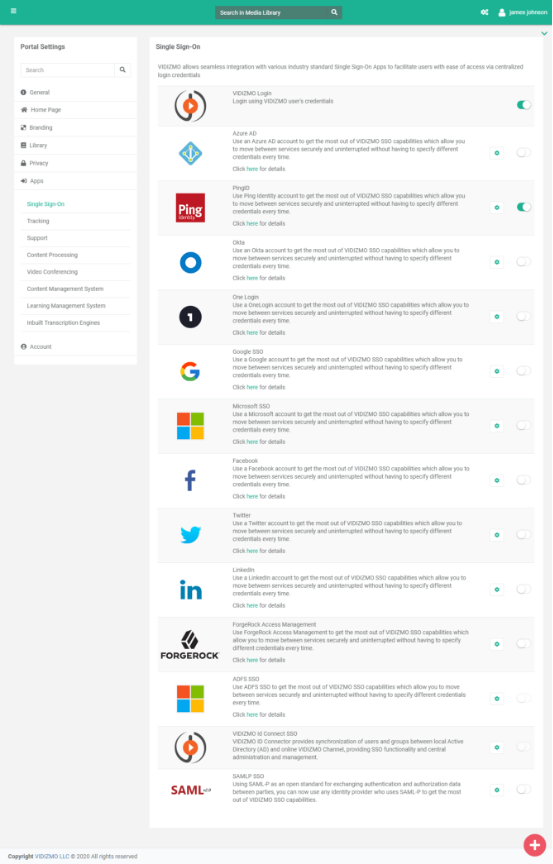Understanding Single Sign-On
Single sign-on (SSO) is an authentication process that allows a user to access multiple applications with one set of login credentials regardless of the application’s platform, technology, or domain. This allows ease of use for the end users and ease of management for administrators.
Concept
To provide high interoperability with your existing organizational IT systems, VIDIZMO offers the most flexible options for you to integrate with a wide range of single sign-on authentication providers, including:
1. Directory services such as Azure AD, ADFS, AWS, etc.
2. Identity Access Management (IAM) services such as Okta, OneLogin, Ping, Centrify
3. Third-party login services such as Facebook, Google, Office 365, Twitter, LinkedIn, etc.
For integration, VIDIZMO can use your organization’s existing identity providers to authenticate employees to use VIDIZMO video platform. To achieve this, VIDIZMO supports OpenID Connect (OIDC) authentication protocol.
With the ability to integrate with any identity provider, VIDIZMO offers your organization high flexibility and low cost of SSO integration with an identity provider of your choice. Not only this but with an app model SSO integration, VIDIZMO makes the integration as easy as enabling/ disabling your identity provider from within the platform administrator interface in minutes.
Single Sign-On Apps in VIDIZMO are as follows:
VIDIZMO Login
Enabling this option allows your Portal users to login to the system using their VIDIZMO-specific credentials. These are the credentials used by the user while registering for the Portal or by the Manager or administrator while adding users to the Portal. By default, this option is enabled and cannot be disabled if any other SSO app is not configured on your Portal.
Azure Active Directory (AD)
Azure Active Directory (AD) is a comprehensive cloud-based multi-tenant service from Microsoft that helps you avail identity and access management capabilities for applications running in Microsoft Azure or on-premises. In addition to the added security due to the multi-factor authentication and conditional access, its single sign-on gives enterprises an option to integrate with many cloud applications such as Office 365, Salesforce, Dropbox etc.
Ping Identity
PingID provides both on-premises and cloud-based solutions. PingID is primarily known for its multi-factor authentication (MFA) capabilities with adaptive authentication policies. PingID protects applications accessed via single sign-on (SSO), integrates seamlessly with Microsoft Azure AD, Active Directory Federation Services (AD FS) and Windows Login, and allows you to embed branded MFA functionality directly into your own application.
VIDIZMO offers seamless integration with PingID due to its intrinsic support for industry-standard authentication protocols. This integration is designed to work seamlessly, regardless of how you've configured your VIDIZMO deployment.
Okta
Okta provides its users a single platform for identity and access management at an enterprise level coupled with a unique functionality of branching the users into functional groups within an organization to help role-definition and custom permission grants. Furthermore, it provides automated user life-cycle management for increased ease of on-boarding and off-boarding an employee from an organization.
OneLogin
OneLogin provides unified access management for both SaaS and on-premises applications in one solution. It also offers smarter security and customer-centricity.
Google SSO
VIDIZMO also allows ease of login by enabling you to sign in with your Google Account—the same account you already use with Gmail and other Google services. In order to configure your Google SSO on your VIDIZMO application.
Microsoft SSO
Microsoft sign-in helps centralize the authentication process by letting users sign into any application using Microsoft Account (be it Hotmail, Live or Outlook) with easy integration with all Microsoft Applications such as Office 365, Azure Active Directory. This helps to fasten the sign-in process and makes it more convenient for the end-user. In order to configure your Microsoft SSO on your VIDIZMO application.
Facebook
VIDIZMO allows centralized login using Facebook credentials which provides a great amount of ease to VIDIZMO users as Facebook is one of the largest social media sites with billions of users.
Twitter
VIDIZMO also offers SSO options with Twitter, allowing Twitter users to readily sign-in to their VIDIZMO Portal without the hassle of going through the registration process. In order to configure your Twitter SSO on your VIDIZMO application.
LinkedIn
Deemed popular for its pool of professional users, your LinkedIn credentials can also be used to sign in to VIDIZMO, allowing employees to sign in with their business contact information and work-specific details. In order to configure your LinkedIn SSO on your VIDIZMO application.
ForgeRock
ForgeRock Access Management is a single, unified solution that provides a comprehensive and flexible set of services on the market for today’s identity and access management (IAM) requirements. Whether users sign-on from a mobile device, connected car, home appliance, or the next innovation, ForgeRock ensures a safe and delightful experience.
ADFS SSO
Active Directory Federation Services (ADFS) is a Single Sign-On (SSO) solution created by Microsoft. As a component of Windows Server operating systems, it provides users with authenticated access to applications that are not capable of using Integrated Windows Authentication (IWA) through Active Directory (AD).
VIDIZMO ID Connect SSO
VIDIZMO ID connect provides synchronization of users and groups between local Active Directory (AD) and VIDIZMO Portal web application, Providing SSO (Single-Sign-On) functionality, central administration, and management.
SAML P SSO
SAML allows its users to seamlessly access multiple applications with their same credentials offering them faster and efficient business conduct. VIDIZMO provides SSO functionality to all its customers with SAML making it easier for them to login without having to type in different credentials every time.

Note Users who belongs to the group with the SSO Apps feature permission enabled can access SSO Apps within the portal.